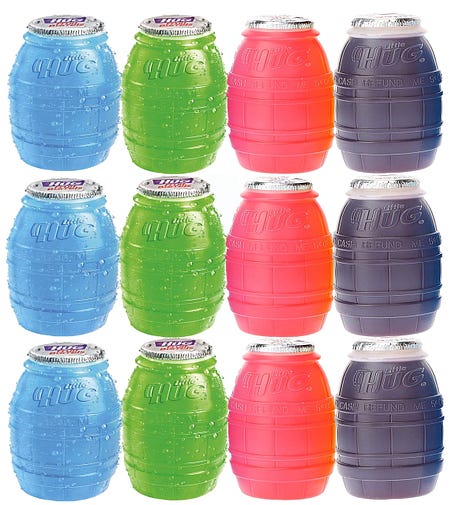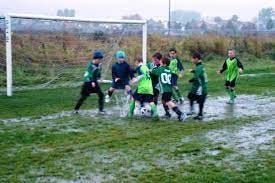Being Bad at Sports Is Good for Kids
It's so much healthier than not playing at all. As we face down a crisis of sports participation, we need a renewed commitment to getting kids involved.
What are your memories of playing sports as a child?






Do they include:
Itchy polyester uniforms?
Gap-toothed photos of you kneeling next to a soccer ball?
Treats after the game? Little barrels of syrupy grape and orange drink with foil tops?
Muddy, slimy fields?
Instant ice packs held to bleeding noses?
Dad coaches who openly admitted not knowing the rules of the game they were coaching?
The euphoria you felt when the best player on your team paid you a compliment?
Those were the days.
As you know already if you are a parent, things have changed. For everyone else, here’s a quick briefing on the state of youth athletics:
Participation is way down
Most American kids today aren’t involved with any team sport. According to a 2019 survey of parents by Project Play, which is based at the Aspen Institute and publishes a wealth of useful data on this subject, only 38 percent of children aged 6-12 are playing something.
When kids do participate, it’s not for long. The average soccer player quits at nine. Baseball and softball players typically bury their gloves in a dusty corner of the garage before turning eleven. It’s a little dated but check out this 2015 Wall Street Journal article describing youth baseball leagues closing up shop and one town where every game features the same two teams… because that’s all they’ve got. (This is the premise for a Will Ferrell movie that writes itself.)
Costs have ballooned
Increasingly, rich kids play sports. Poor kids don’t. This has become true to such a degree that we could wade through data until our eyes glaze over. For the sake of brevity, let’s stick to a few basics:
The Center for Disease Control and Prevention reports that 70 percent of children in households with six-figure incomes played sports in 2020, compared to just 31 percent of children living below the poverty line.
Project Play says the share of kids playing a healthy amount of sports is going up among the wealthy – and down among the least well off. This table gives you a good idea of why.
RAND surveyed parents and confirmed the obvious: When middle and higher income youths don’t play sports, the most common reason is the time required. When their lower income peers don’t play, it’s most likely too expensive.
Super competitive parents have lost the run of themselves
I’m appropriating an Irish phrase that’s kinder than saying they’ve lost their marbles. We’re not talking about most parents. But there’s a non-trivial subset who push their children to ever-higher levels of training and competition from a young age. We’re talking about them. What are they up to?
They pay thousands of dollars for travel teams with fancy uniforms, dedicated training facilities and paid coaches beginning at age seven.
They hurl abuse at umpires and officials. Fights are breaking out. Luckily, we still have heroes (and style icons) like Don Bozzuffi, below, who is the Little League director in Deptford, NJ. Exhausted with nasty parents, Don instituted a new rule requiring anyone who violates the local code of conduct to umpire three games or face a one year ban from the fields. The fact that he received national attention indicates we all know what he’s dealing with.
They push their kids to specialize too early. Guidelines recommend delaying specialization in a single sport as long as possible and not spending more time on a sport than a child’s age in years - i.e. no more than 11 hours per week for an 11 year-old. Don’t play the same sport more than eight months per year. Rest two days a week. And yet we have parents declaring that their eight year-old can’t play youth soccer with his classmates anymore because of his blossoming career as a dual-threat quarterback.
Their commitment to intense participation may be hurting their kids. Half of all youth sports injuries are due not to twisting an ankle in a gopher hole or catching a ground ball off the dome but to overuse, according to the National Athletic Trainers’ Association. Tendinitis. Inflammation. Bad stuff for a child.
Yes, this all sounds quite overboard. My purpose, however, is not to ridicule outstanding young athletes or their loving parents who genuinely want them to maximize their joy and potential, even if they do it in batty ways. More power to them. I actually think they’ve got a key part of the equation exactly right. Their kids are engaged.
Sports are really, really good for kids
Athletes earn higher grades and miss fewer days of school. Particularly when they play team sports rather than individual sports, they have fewer mental health issues. They have higher self-esteem and are less likely to abuse substances. They get more exercise. They’re better at managing time. They graduate from college at higher rates. So much good stuff.
When we consider how the pandemic has rusted the gears of American childhood, sports are the most potent remedy.
Why? They get kids off screens. They get hearts pumping. They require socialization and in-person communication with same-age peers. They are scalable. They build on traditions that already exist.
The main problem is that not enough American youth are benefitting from this almighty sports elixir. Instead, we’re moving in the wrong direction.
The key to increasing participation, I suspect, is to deliberately invest in sports opportunities where being good is deprioritized and the sole objective is playing. Let’s lower the stakes.
How do we do it? Community leaders have a huge role. Here are six ideas:
#1. Get clear on goals
The two most important metrics for youth sports are the number of kids who participate and - just as important - the number that continues to participate the following year. Define success in terms of persistence. Simple.
#2. Reduce costs
As we learned above, some sports are almost preposterously expensive. Ice hockey, we’re looking at you. For public investments, prioritize more affordable options such as flag football, volleyball, and track. Invest resources to sell equipment - including things like gym shoes and uniforms - at subsidized rates to families with financial constraints. Or follow the example of Edina, MN and hold a massive gear swap that extends the usable life of items while ensuring they reach the kids that need them. Don’t ask families to commute all over the place. Travel - especially car travel and anything requiring an overnight stay - is a big cost driver. Remove every possible barrier.
#3. Increase the pipeline of coaches
One of the biggest reasons there aren’t more sports teams is the scarcity of qualified, background-checked adults who can lead them. This should be a higher priority for our national and state service programs such as AmeriCorps. Energetic young people who recently played sports themselves make excellent coaches. Service programs direct talent where we need it most. This is where we need it.
#4. Run multiple teams - or invest in intramurals
At large high schools, it’s very competitive to make the cut in high demand sports like basketball, soccer, and baseball/softball. I often hear about outstanding, dedicated players who don’t even make the freshman team. Crushing. They’re forced to search for an alternative sport or quit sports altogether. But why? Massive schools should consider having 3-4 freshman soccer teams of different levels. Find the field space and the coaches. Or they could organize intramural leagues (once very popular, now moribund) with teams for each class, etc. The objective here is inclusion, not exclusion.
#5. Prioritize options for middle school athletes
Almost all kids start out playing sports, but as they age there is a steady outflow of participants and very little inflow. When they no longer want to do soccer and baseball/softball, what do they move to? We need sports that have a low bar of entry (in terms of skills, commitment, and costs) for kids aged 11 and up.
This is where no-cut sports are ideal - especially cross country, which lends itself to huge teams that can practice together in almost any school location and meets where all the kids can run, regardless of their performance level. Best of all, it requires little more than a pair of comfortable shoes. Swimming could be another good option - it’s not that hard to schedule more heats of each event - if we still invested in pools (which we do not) and many families weren’t scared off by the hyper-competitive vibe swimming tends to give off.
#6. Don’t neglect indoor sports
I live in Chicago. You may be aware that we have a notable winter. We’re not alone, either. Why aren’t there more youth bowling teams in northern communities? Is anybody else using the lanes from 3-6pm on weekdays? Martial arts, wrestling, ping pong, badminton, and floor hockey are good indoor options that don’t require a ton of physical space. Do your local schools sponsor teams in these sports? If not, why not?
At the end of the day, this is really about parents
We’re the ones who matter. If we tell our kids that the only reason to play sports is to be a star or to earn a college scholarship, they’ll want to quit as soon as those dreams recede. If we treat sports as part of a balanced, healthy childhood, they will too.
How about this plan?
Sign your child up for at least one sport in every season. Don’t take no for an answer.
Show up to watch. Stay off your phone.
Don’t act like a dipstick toward the officials or the other parents.
Cheer for the other kids - and the kids on the other team - rather than just your own child.
Stop caring whether your child is good. Just let it go. If they are trying hard and enjoying it even a little bit, it’s a success.
Volunteer to coach. If you don’t know anything about the sport, congratulations. You’ve just joined a storied and glorious parental tradition.
After the game, praise effort, sportsmanship, and improvement. Don’t talk very much about the score.
This is one of the most important things we can do for our kids. Some of them are going to be elite. Which is great. But the benefits of sports are just as meaningful for all kids. They should all be playing. Syrupy grape drink barrels for everyone.
Personal postscript
I benefitted tremendously from participation in youth sports. When I look back, I can hardly believe how fortunate I was to have two parents who made it possible for my siblings and I to play without ever making it about them. Their support was unconditional. They ended up with two kids - my sister and I - who collected a lot of friends and memories and a third - my brother - who has collected five (updated: six) Super Bowl rings. Thanks, Mom and Dad.
I’m also grateful to my coaches. I have specific memories of just about all of them. Once again, I was awfully lucky. For instance: One of my coaches was recently named the USA Today Coach of the Year. He knew I wasn’t a very talented athlete. But he made my experience as part of a high school football team very special anyway. He did the same for hundreds of others.
As I was working on this piece, I was a little bit overcome by the realization that I never told most of my coaches how much they meant to me. I was a kid, I guess. I wish I’d done that. Now that I’ve had a chance to coach youth teams myself, I know that it’s incredibly rewarding on its own - seeing the kids grow and succeed. Sports are pretty healthy for middle aged dads, too.




